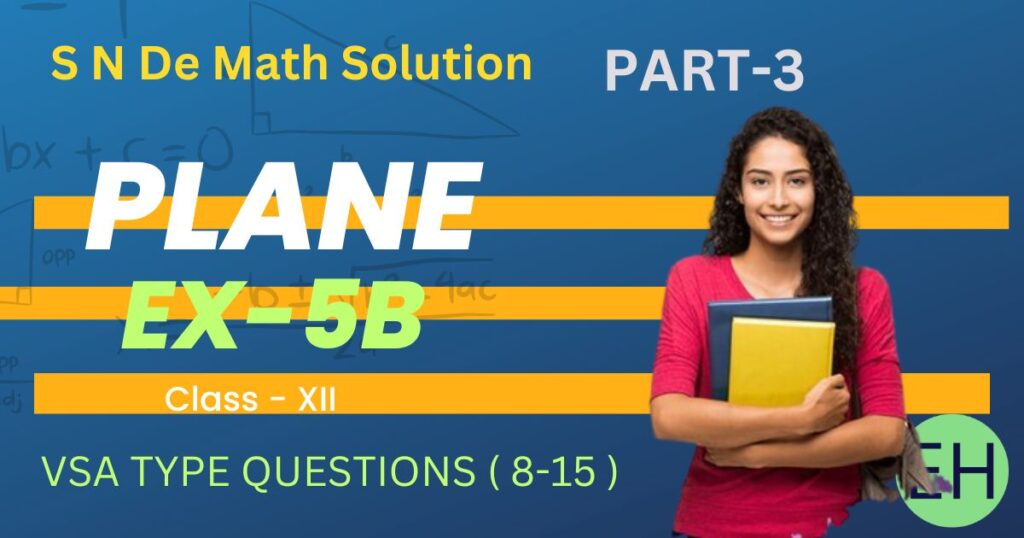In the previous article , we have solved few VSA type questions of Plane Chapter (Ex-2B) of S N De Mathematics(Chhaya). In the following article, we are going to discuss/solve VSA (Very Short Answer) Type Questions of S.N.Dey Mathematics-Class 12 of the chapter Plane (Ex-5B).

8. Find the distance of the point ![]() from the point of intersection of the line
from the point of intersection of the line ![]() and the plane
and the plane ![]() [NCERT]
[NCERT]
Solution.
Let the position vector of the point of intersection be ![]()
This point lies on the plane ![]()

![]() The position vector of the point of intersection is
The position vector of the point of intersection is ![]() i.e.
i.e. ![]()
So, the distance between the points ![]() and
and ![]() is
is
![]()
9. Find the value of ![]() such that the line
such that the line ![]() is perpendicular to the plane
is perpendicular to the plane ![]()
Solution.
The given straight line is ![]() and the plane is
and the plane is ![]()
Since the straight line (1) is perpendicular to the plane (2),
![]()
10. Find the distance of the point with position vector ![]() from the plane
from the plane ![]()
Solution.
The distance of the point ![]() from the given plane
from the given plane ![]()
![]()
11. Find the distance between the parallel planes ![]() and
and ![]()
Solution.
The given planes are ![]() and
and

Clearly, the planes (1) and (2) are parallel to each other.
So, the distance between them is
![]()
12. If the line ![]() is parallel to the plane
is parallel to the plane ![]() , find the value of
, find the value of ![]() .
.
Solution.
The given straight line is ![]() and the given plane is
and the given plane is ![]()
Since the straight line (1) is parallel to the plane (2), so
![]()
13. Find the equation of the plane which contains the line of intersection of the planes ![]() and
and ![]() which is perpendicular to the plane
which is perpendicular to the plane ![]()
Solution.
![]()
The equation of the plane which contains the line of intersection of planes (1) and (2) is
![]()
The plane (3) is perpendicular to the plane ![]()

Now, we calculate the following values in (3).
![]()
Hence, from (3) we get,
![Rendered by QuickLaTeX.com ~\vec{r} \cdot \left[\frac{33}{19}\hat{i}+\frac{45}{19}\hat{j}+\frac{50}{19}\hat{k}\right]-4=0 \\ \text{or,}~~ \vec{r} \cdot (33\hat{i}+45\hat{j}+50\hat{k})-76=0 \longrightarrow(4)](https://examhoop.com/wp-content/ql-cache/quicklatex.com-1f010f59a8730b27fb0ff5c54bce3ea0_l3.png)
So, equation (4) represents the vector equation of the required plane.
14. Find the equation of the plane passing through the points ![]() and
and ![]() and parallel to the line
and parallel to the line ![]() [CBSE
[CBSE ![]() ]
]
Solution.
The equation of the plane passing through the point ![]() is
is
![]()
Since the plane (1) is passing through the point ![]()
![]()
Since the plane is parallel to the given straight line ![]()
![]()
From (2) and (3) we get by cross-multiplication,
![]()
![]() The required equation of the plane is
The required equation of the plane is

15. Find the coordinates of the point where the line through the points ![]() and
and ![]() crosses the xy-plane.
crosses the xy-plane.
Solution.
The equation of the any straight line through the points ![]() and
and ![]() can be written as
can be written as
![]()
So, any point on the straight line (1) can be written as ![]()
If this straight line crosses the xy-plane, then ![]() as on the xy-plane
as on the xy-plane ![]()
![]()
![]()
![]() The co-ordinates of the point where the line crosses the xy-plane is
The co-ordinates of the point where the line crosses the xy-plane is
![]()